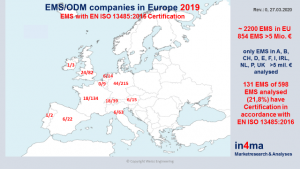The Corona Crisis and the EMS Industry
By Dieter G. Weiss
Conditions similar to those in Italy are also possible in Germany¹
 “We cannot rule out the possibility that we also have more patients than ventilators in this country,” says Lothar Wieler, head of the German Robert Koch Institute. This is the first time he has opposed previous publications², especially by Prof. Busse, the advisor to the Federal Government, who has been criticized by his colleagues in the past and especially today for his statement that there are too many hospital beds.
“We cannot rule out the possibility that we also have more patients than ventilators in this country,” says Lothar Wieler, head of the German Robert Koch Institute. This is the first time he has opposed previous publications², especially by Prof. Busse, the advisor to the Federal Government, who has been criticized by his colleagues in the past and especially today for his statement that there are too many hospital beds.
According to German Health Minister Jens Spahn, there are currently 25,000 ventilators and 28,000 intensive care beds in Germany³, apparently too few.
In February, the Federal Government of Germany had already ordered 10,000 ventilators from Draeger AG & Co. KGaA in Lübeck⁴. While only this figure can be read in the press, 6,500 ventilators have been ordered by the Federal Government of Germany from the medical technology manufacturer Loewenstein Medical in Bad Ems as well⁵. In total, Germany would have 44,500 ventilators by the end of the year. By comparison, there are currently 5,000 adult ventilators in the UK and 900 for children. There are currently no reliable figures for Italy, Spain, France and the USA.
However, ventilators are not currently the only bottleneck for treating severe cases of COVID-19 infection. There are also problems with cannulas for extracorporeal membrane oxygenation (ECMO), a last treatment option in which the blood of the most seriously lung-stricken is discharged from the body and enriched with oxygen. These devices are also difficult to obtain⁶.
Mission Impossible
It is astonishing to read in the press that the vacuum cleaner manufacturer Dyson from Great Britain wants to produce ventilators, that the Italian manufacturer of ventilators Siare Engineering has asked Ferrari, Fiat and Lamborghini for help and the American president has obliged General Motors to build ventilators. Apart from the seriousness of the situation, it is a funny idea that Boris Johnson would be in hospital with a converted vacuum cleaner on his neck.
You don’t have to be a medical expert to know that today’s ventilators are not iron boxes with a pump, just like the iron lung 90 years ago. We also do not talk about small portable devices, such as those used for home use, e.g. in case of sleep apnea. It is so-called ICU -level (Intensive Care Units) devices that are used with various ventilation techniques in intensive care units. Depending on the complexity, such devices cost between 20-100T USD.
Accordingly, Stefan Draeger, CEO of Draeger AG, speaks out against this strategy in an interview with German magazine Spiegel⁷: “We have spoken to Daimler, who would also like to help. But it’s not that easy, we can’t build cars either.” To understand the problem and complexity, you should talk to a doctor and find out what a volutrauma, a barotrauma and an atelektrauma is.
A ventilator or respirator is an electrically controlled, electromagnetically or pneumatically driven machine for the ventilation of persons with insufficient or exposed self-breathing. The heart of this machine are electronics, sensors, complex software, screen and switches. So who would be able to produce such equipment?
The EMS industry stands ready and wants to help
The answer is actually quite simple. If the manufacturers (OEMs) of such systems really do not have sufficient capacity, then they should turn on the companies that are already building these devices on behalf of the manufacturers. These production service providers are known to every employee in the electronics industry: Electronic Manufacturing Service companies, EMS for short, are well versed in the business. They are production service providers and already produce all kinds of electronic devices on behalf of the electronics industry. Even the well-known manufacturer of Apple products, Foxconn, has been producing ventilators for other companies at its factory in Pardubice, Czech Republic, for more than a year. EMS company M&M Qualtech Ltd. is already producing equipment for Medtronic, arguably the largest manufacturer of ventilators, in Galway, Ireland. Draeger, Hamilton, imt medical, Philips medical also use EMS companies to support them. The author does not currently know whether Loewenstein medical, Getinge, Air Liquide (Eove), Siare Engineering and GE Medical have Subcontractors as well. However, three EMS companies are known in Europe, which have been producing ventilators for their customers for some time and have mentioned spare capacities in conversation with the author.
We will be charitable and assume that the reason the companies with the right capabilities are not being approached is ignorance, not politics. The profit margins of these manufacturers (OEM) are very healthy. For example, Hamilton generates an annual turnover of 27.8 million euros with 168 employees (2018 figures) at its Romanian plant in Timis and generates a net profit of 26.4%, which can be read at any time in the Romanian company register.
Of course, you can’t just commission any EMS to produce medical equipment, because they are “life-critical systems” on which people’s lives depend. Now there is a minimum requirement for this, the approval according to ISO 13485. ISO 13485 is an ISO standard that represents the requirements for a comprehensive quality management system for the design and manufacture of medical devices. in4ma, the market research company for the EMS industry in Europe, carried out a short analysis in Western Europe (excluding Scandinavia) and evaluated all companies with a turnover of >5 million euros. 131 companies in Western Europe have this approval with Scandinavia and Eastern Europe, probably more than 160 companies that could start production at any time. (see Graph 1)
 In addition, in case of even higher demand, EMS companies with other equivalent approvals would also be eligible before requesting support from non-approved companies and letting the wheel be reinvented.
In addition, in case of even higher demand, EMS companies with other equivalent approvals would also be eligible before requesting support from non-approved companies and letting the wheel be reinvented.
Apparently, at least in the United Kingdom, this has now been understood. At least that’s what Neil Sharp of the British EMS manufacturer JJS manufacturing Ltd.⁹ reports. As of 16 March, more than 60 UK manufacturers (unclear whether EMS alone) had been contacted by the government and had been sent technical descriptions and specifications for ventilators with a request to consider whether production could be converted . The results of these requests are not yet known. It is surprising, however, that the British Government is explicitly looking for manufacturers from the UK, ostensibly to rule out logistical problems in the procurement of foreign suppliers.
Accordingly, the letter to the 60 UK manufacturers mentions a national crisis and calls on the companies to produce 20,000 devices within two weeks if possible.
In the USA there are also many EMS companies that would like to help but have not been asked for help so far. Interestingly, a company (Keytronics, global No. 48 of the Global TOP 100 EMS of the in4ma list) contacted the government via Twitter and truly received a response from Donald Trump¹⁰. It is unclear whether this has led to orders for Keytronics. It is estimated that around 160 EMS companies in the United States alone are able to produce such devices, all of which have better know-how than General Motors.
Triage like in war times
If you have made it through this article so far, you have to be asking yourself, is this problem being handled as efficiently as it could be? On March 28th, we there was an internet article saying that Draeger wanted to deliver ventilators and did not receive any information on which hospitals should be supplied. A question from the press to Mr Spahn did not get an answer. Then all the news about this could not be found on the internet a day later.
What is clear to the author, at least, is that various governments in many countries do not even have a clear picture of manufacturers and their capacities, let alone where additional capacity could be created by activating existing EMS. Although the German government believes that it has done enough for Germany due to existing orders, there is still a lack of coverage in Italy, France, Spain and the UK. After all, the Corona crisis is not a national problem, but a global crisis, where everyone must work together to ensure adequate supplies of ventilators. The author does not have complete capacity data, but welcomes additional information (in4ma@gmx.de).
According to the Internet, Medtronic is the largest manufacturer of ventilators. Draeger is estimated to have about 15,000 devices a year, while Hamilton also makes about 15,000 devices a year¹¹. Löwenstein medical has produced 1,500 ICU-level devices and 20,000 home-level devices in the past. Since the German federal government’s order for 6,500 ICU-level devices has been accepted, it can be assumed that one of these companies is able to convert production accordingly and then have a capacity of at least 6,500 ventilators.
That’s just three of the above ten manufacturers of ventilators, and the capacity of the other manufacturers is certainly not limited to 750 devices per year, as Neil Sharp⁹ writes. The author currently assumes an annual capacity of about 100,000 devices worldwide (after all, the manufacturers in the Far East are not mentioned yet) and the device manufacturers almost certainly have much more precise figures, which they keep nicely in the drawer.
It is not a national problem and it is not a question of keeping everything under wraps and protecting the know-how of manufacturers. But as long as more money is spent on guns than on our health system, we have to ask how developed our society is. According to an insider, hospitals in Switzerland are now in the work of training their staff to decide who is connected to a breathing apparatus (triage) when the number of cases is soaring.
Italy and Spain have long since crossed this point. Nevertheless, there are growing voices on the internet that the precautionary measures should finally be revoked. A quote from the senior physician Michael Horn of the emergency department of the Heinrich-Braun-Hospital Zwickau¹²: “In the meantime, there are voices that announce that one can let the elderly go (meaning die) one has to ask: Are you still clear in your head? When do the disabled, the asthmatics and the other chronically ill follow? Is this arrogant ignorance or is it simply stupidity?”
The Corona Influence on the EMS Industry
To examine the impact of the pandemic on the EMS industry, a first of four surveys were launched late last week by a group of selected EMS companies. It was shown that sick leave currently averages 12.2%, but this has been divided into different revenue groups for the reporting companies. A third of the companies had sick leave of more than 10%, peaking at 45%. A company with also high sick leave wrote:
“We see a total insecurity of the employees; when the throat only scratches slightly, the employees come and ask what they should do. As part of the duty of care, we must inform staff to call their GP. This regularly leads to employees being incapacitated for 14 days after the telephone diagnosis. These are enormous costs that the company has to bear*. If this continues to increase, the company can only be protected by 100% short-time working.”
*This information might not be understood in the US. If an employee reports sick, the employer is obliged by law to continue to pay the employee for another six weeks. After that, this responsibility is on the health insurance, which every employee has. (We are always looking for qualified employees in Europe, you will love it)
The capacity is currently around 85% due to sick leave. Occasionally, there are problems with wage-intensive jobs in the THT sector.
There is also no sign of a serious slump in order intake. At present, it is even better than feared, at minus 1.6% compared to the plan, with no dependence on the share of the motor vehicle industry. It is rather the case that the companies with a car share greater than 20% have a better development in order intake than companies with a lower proportion of automotive electronics.
For the supply of components, the individual comments were forwarded anonymously to the participating companies. All in all, there are currently no serious problems of parts, but the industry expects this to change in the next four weeks.
The EMS industry feels, that they are still in a relatively good situation but expect, that the wave of problems in sickness leave, lower capacity, lower order intake and supply problems will hit them within the next four weeks.
The following are all the sources of the statements used and/or quoted in this article. Unfortunately, the figures and information published in the general press are very contradictory:
¹ Lothar Wieler, Chef Robert Koch Institut, deutsche Bundesoberbehörde für Infektionskrankheiten
² aerzteblatt.de 12.3.2020 „Überlastung deutscher Krankenhäuser durch COVID-19 laut Experten unwahrscheinlich“ Prof. Reinhard Busse, Leiter des Fachgebiets Management im Gesundheitswesen an der TU Berlin und Co-Direktor des European Observatory on Health Systems and Policies
³ Tagesschau.de 12.3.2020 „Intensivplätze teils stark belegt“
⁴ ntv.de 13.3.2020 „Bund ordert 10.000 Beatmungsgeräte“
⁵ SWR Aktuell 16.3.2020, „Bundesregierung ordert 6.500 Beatmungsgeräte in Bad Ems“
⁶ Tagesschau.de 18.3.2020, „Kliniken kämpfen mit Lieferproblemen“
⁷ Spiegel International 27.3.2020 “Absolutely Mission Impossible”
⁸ Wikipedia
⁹ jjsmanufacturing.com/blog
¹⁰ LinkedIn, Keytronics, 24.03.2020
¹¹ Reuters 13.03.2020 „Regierungen reißen sich wegen Coronavirus um Beatmungsgeräte“
¹² Facebook Gruppe Chemnitz live 27.3.












